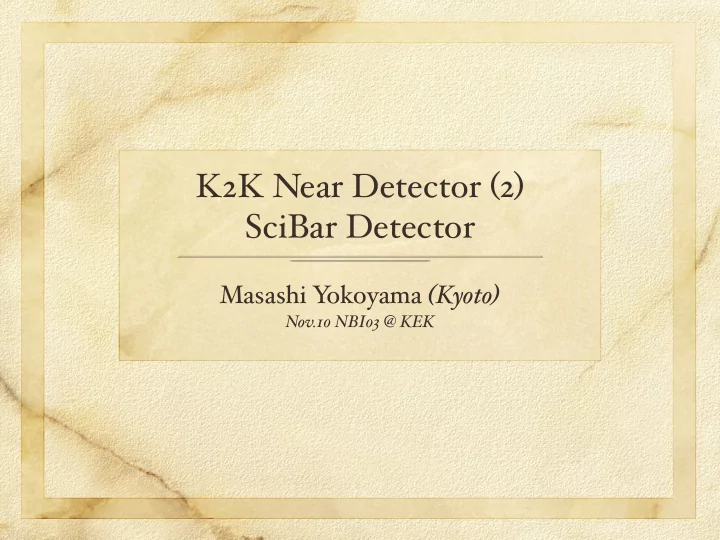

K2K Near Detector �2� SciBar Detector Masashi Y okoyama �Kyoto� Nov.10 NBI03 @ KEK
Introduction
Motivation Events K2K result indicates 12 ∆ m 2 ≈2.8x10 –3 10 for ν µ ↔ ν τ oscillation 8 Oscillation maximum at 6 E ν ≈0.6GeV for 250km of baseline 4 Study of neutrino 2 interaction at low energy is 0 0 1 2 3 4 5 important to maximize E ν rec sensitivity ⇒ Construct new detector
Requirements Clean reconstruction of vertex High efficiency for all particles Low momentum threshold for tracks (esp. protons) Full active detector Fine segmentation µ /p/π separation Range+dE/dx EM calorimetry for study of ν e /π 0
Full-active tracker with Scintillator Bar s!! K2K Front Detector SciFi/Water target SciBar detector Muon chamber 1kt To Super-Kamiokande Water Cherenkov Detector ν beam
Detector design
SciBar detector overview 3x3x1.8m 3 (Tot. mass ~15t) ~300 interactions/day, ~40,000 int./3x10 19 POT expected if fid. mass=10t Full active, fine grained 1.3x2.5cm 2 , 64 layers High efficiency for all particles from vertex Threshold for protons ~350MeV e/π 0 ID capability w/ EM calorimeter ⇒ Precise study of ν interaction!
Scintillator and fiber Scintillator 2.5x1.3x300cm 3 MINOS-type extruded scintillator (made at FNAL) 64 layers (X+Y) 14336 channels in total Wave length shifting fiber 1.5mm Φ x 360mm Kuraray Y11 Attenuation length: ~360cm (all fibers measured before installation) Light yield: 20p.e./cm for MIP after 40cm of fiber
Multi-Anode PMT Hamamatsu H8804 Fibers w/ cookie 64ch w/ 2x2mm 2 pixel size after polishing Alignment w/ fiber better than 300µm Cross-talk to adjacent channel: ≤3% All channels calibrated before installation Gain~5x10 5
FADC FADC FADC FADC FADC VA/TA FADC FADC FADC x28 x224 FADC FADC FADC FADC VME-bus FADC FADC FADC VME-PCI BRIDGE VME-IF Controller timing VA/TA& spill info Linux PC MA-PMT 64ch VA/TA FIFO Readout electronics Large number of channels (~15,000) VA frontend LSI: Multiplex analog DAQ Board signal Frontend Board Readout 64ch with (FEB) a signal line Low noise: ~0.3p.e. (MIP=10-20p.e.) Large dynamic range Linear up to 300p.e. TDC (64ch) low energy proton Trigger module Fast trigger/timing signal Timing Distributor TA LSI chip at frontend 32-ch ORed output
Electron Catcher 262 cm Modules from CHORUS ν Beam “spaghetti” calorimeter 1mm diameter fibers in the 8 cm grooves of lead foils 4x4cm 2 cell read out from Readout Cell both ends 4 cm 30 horiz. + 32 vert. modules ν beam (11X0) placed just downstream of SciBar main detector Expected resolution: 14%√E Linearity: better than 10%
Photo Gallery
Main SciBar E-catcher
PMT (backside) WLS fibers VA/TA chip
Just Completed! Aug. 22, 2003
9 1 2 Data taking started on Oct.7... ID 8220 Preliminary 400 Entries 3092 Arbitrary unit 350 Mean 19.07 RMS 8.641 300 Extensive calibration work 250 Light yield for MIP 200 ongoing (Cosmic-ray µ) 150 100 @40cm from PMT Gain, timing, alignment... 50 0 0 20 40 60 80 100 Software development p.e./cm Timing of first hit in beam event (traking, MC simulation after tracking tuning) started Events (arb. unit) 80 34 5 6 7 8 So far, SciBar looks working 60 as expected 40 (= excellent performance!! ) 20 0 –0.5 0 0.5 1.0 1.5 2.0 time( µ s)
Event Gallery
ADC TDC (in-time) Neutrino event (1) Top view Side view MRD MRD ν beam
ADC TDC (in-time) Neutrino event (2) Top view Side view ν beam
vertex! Neutrino event (3) NC pi0 cand. Top view Side view
Neutrino event(4) ν e candidate Top view Side view E-catcher E-catcher
Summary SciBar is Full-active (15t total volume) Fine-grained (1.3x2.5cm) detector for precise studies of ν interaction Stably working for one month, data quality looks excellent Still lots of work (and fun) to be done, but making rapid progress towards physics results
Backup Slides
Extruded Scintillator • Mix poly-stylene with PPO 1%, POPOP 0.3% – Maximum of emission spectrum : 420nm • 1.3 x 2.6 x 300 cm 3 • 1.8mm diameter hole at the center • TiO 2 coating ( t 0.25mm) – As a reflector 300cm – Extruded together 1.3cm 2.5cm Light yield uniformity <5%
Wavelength Shifting Charged particle Fiber • Kuraray Y11(200)MS 1.5mm diam. • Attenuation length : 3.6m Secondary Scintillation emission • Absorption peak – 430nm • Emission peak – 476nm 400 500 600
Gain monitoring w/ LED (56 × 4) (4)
Pedestal(Main Part) Page1 pedestal(count) 2040 2038 view 0 :layer 0 :strip 0 2036 2034 2032 2030 2028 2026 2024 2022 5020 5040 5060 5080 5100 5120 5140 5160 run pedestal(count) 2030 2028 view 0 :layer 0 :strip 1 2026 2024 2022 2020 2018 2016 2014 2012 5020 5040 5060 5080 5100 5120 5140 5160 run
Stability of gain Gain(ADC/PIN) 0.17 view 1 :layer 8 :strip 46 0.165 +2% 0.16 0.155 -2% 0.15 0.145 5020 5040 5060 5080 5100 5120 5140 run
VA/TA readout chip preamp. sample&hold VA serial output slow shaper ( energy information ) CH1 multiplexer TA (32ch OR) fast shaper discri. ( trigger, CH2 timing information ) CH32 ~1 µ s
p.e./layer Proton ID w/ dE/dx Beam test w/ p/pi separation prototype, w/ <10% mis-ID 1 cell only below 1.2GeV/c Proton possible by more sampling points p (GeV/c)
10% precision w/ dE/dx only Proton momentum w/ dE/dx
Recommend
More recommend